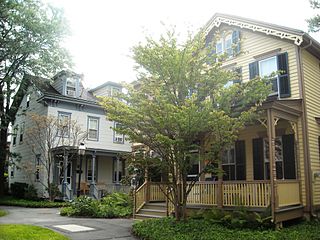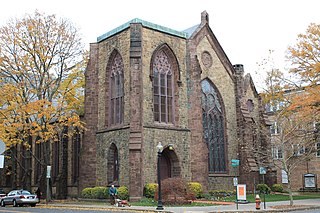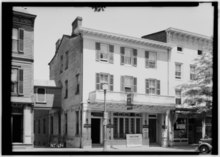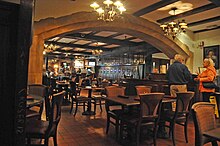
Princeton University is a private Ivy League research university in Princeton, New Jersey. Founded in 1746 in Elizabeth as the College of New Jersey, Princeton is the fourth-oldest institution of higher education in the United States and one of the nine colonial colleges chartered before the American Revolution. The institution moved to Newark in 1747, and then to its current campus, nine years later. It officially became a university in 1896 and was subsequently renamed Princeton University.

Nassau Hall, colloquially known as Old Nassau, is the oldest building at Princeton University in Princeton, Mercer County, New Jersey, United States. In 1783 it served as the United States Capitol building for four months. At the time it was built in 1756, Nassau Hall was the largest building in colonial New Jersey and the largest academic building in the American colonies.

The University Cottage Club or simply Cottage Club is one of eleven current eating clubs at Princeton University, in Princeton, New Jersey, United States. It is one of the six bicker clubs, along with The Ivy Club, Tiger Inn, Cap and Gown Club, Cannon Club and Tower Club.

Palmer Square is a public square and planned development in the heart of Princeton, New Jersey across from Nassau Street and Princeton University that today forms a collection of shops, restaurants, offices and residential spaces.

Franklin Park is an unincorporated community and census-designated place (CDP) located within Franklin Township, in Somerset County, in the U.S. state of New Jersey. As of the 2010 United States Census, the CDP's population was 13,295. Route 27 bisects the village and serves as the dividing line between the two counties. The adjacent sections of South Brunswick and North Brunswick, Middlesex County on the east side of Route 27 are also known as Franklin Park, but are not included within the CDP's boundaries.

The Princeton Battle Monument is located in Princeton, New Jersey, adjacent to Morven and Princeton's borough hall. The monument commemorates the January 3, 1777 Battle of Princeton and depicts General George Washington leading his troops to victory and the death of General Hugh Mercer. It stands 50 feet (15 m) tall and was inspired by carvings on the Arc de Triomphe in Paris. Designed to visually anchor the western end of Nassau Street, the monument and its park are a legacy of the City Beautiful movement.

The Princeton Battlefield in Princeton, Mercer County, New Jersey, United States, is where American and British troops fought each other on January 3, 1777, in the Battle of Princeton during the American Revolutionary War. The battle ended when the British soldiers in Nassau Hall surrendered. This success, following those at the Battle of Trenton on December 26, 1776, and the Battle of the Assunpink Creek the day before, helped improve American morale.

The President's House, also known as the John Maclean House, or simply the Maclean House, in Princeton, Mercer County, New Jersey, United States, was built to serve as the home of the President of the College of New Jersey, which later became Princeton University. It was completed in 1756, the same year as Nassau Hall. United States Founding Father John Witherspoon lived here from 1768 through 1779, during which time he served as a delegate to the Continental Congress and signed the Declaration of Independence. George Washington occupied Maclean House in January 1777, during the Battle of Princeton and in 1783 while Congress met in Nassau Hall.
Lucius Horatio Stockton was an American lawyer who served as U.S. Attorney for the District of New Jersey from 1798 to 1801. His rise to this position was relatively swift: he was admitted to the New Jersey bar in 1791; he became counsellor in 1794; and in April 1797, he was appointed sergeant-at-law.

5 Beekman Street is a building in the Financial District of Manhattan in New York City, United States. It is composed of the 10-story, 150-foot-tall (46 m) Temple Court Building and Annex and a connected 51-story, 687-foot-tall (209 m) condominium tower called the Beekman Residences, which contains 68 residential units. The 287-unit The Beekman, a Thompson Hotel, also known as The Beekman Hotel, occupies all three structures.

The Princeton Historic District is a 370-acre (150 ha) historic district located in Princeton, New Jersey that was listed on the U.S. National Register of Historic Places in 1975. It stretches from Marquand Park in the west to the Eating Clubs in the East, from the Princeton Cemetery in the north to the Graduate College in the south. The district encompasses the core parts of the campuses of the Princeton Theological Seminary and Princeton University. It also includes the business district centered on Nassau Street and many historic homes, both mansions in the western section and more humble dwellings in the Witherspoon/Jackson neighborhood. Notable churches within the district include Nassau Presbyterian Church, Trinity Episcopal, Nassau Christian Center, and the Princeton University Chapel. The district is home to seven of Princeton's nine, and New Jersey's fifty-eight, National Historic Landmarks, the largest concentration of such sites in the state.

The General John Frelinghuysen House is a historic building located in Raritan, New Jersey. The older west wing was originally a tavern, built sometime before 1756 by Cornelius Bogert, when it also served as the town's meeting hall. It was bought in 1801 by John Frelinghuysen and then came to be known as the Frelinghuysen Homestead. It is an excellent example of early 19th century Federal architecture in New Jersey. In 1975, it was donated by Peter Frelinghuysen, Jr. to the borough and now serves as the Raritan Public Library.

Cedar Grove is an unincorporated community located within Princeton in Mercer County, in the U.S. state of New Jersey. In the 19th and early 20th centuries it was a village with a church, blacksmith, and schoolhouse. It is located on the brow of a hill along Great Road from Princeton to Blawenburg. The Cedar Grove area was settled by French families of some prominence who were Huguenot refugees, including Louis and Maria Tulane, to whom Paul Tulane, philanthropist and founder of Tulane University, was born in 1801. The suburbanization of Princeton Township in the second half of the 20th century led to a loss of Cedar Grove's place as a distinctive settlement, though some older buildings are still extant. As the main route of Great Road has been relocated to a bypass to the east, the area is much less traveled. Most of the area's land is owned by the Tenacre Foundation, a Christian Science care and nursing facility.

The Nassau Christian Center is an Assemblies of God church in Princeton, New Jersey located at 26 Nassau Street. It is housed in an historic church building built in 1868 that was once home to Princeton's Second Presbyterian Church, later known as St. Andrew's Presbyterian. The Christian Center was founded in 1978 and leased, purchasing in 1980, the then empty building from Nassau Presbyterian Church, which had been formed by the merger of Second Presbyterian with First Presbyterian of Princeton in 1973.

The Peacock Inn is a historic restaurant and inn in Princeton, New Jersey. The building itself dates to the 18th century and was originally located at the corner of Nassau Street and University Place. During the American Revolution it was the home of Jonathan Deare, and played host to members of the Continental Congress when they met in nearby Nassau Hall. It was moved to its current location in 1875 by famed archaeologist and Olympic athlete William Libbey. Joseph and Helen O'Conner purchased the property in 1911 and opened the Peacock Inn, naming it after an inn in Derbyshire, England. The Inn has 16 guest rooms but is most known for its restaurant, consistently rated one of the finest in the state.

The Walter Lowrie House is located at 83 Stockton Street in Princeton, New Jersey, United States, and is the official residence of the president of Princeton University. The mansion was built in 1845 by Commodore Robert F. Stockton for his son John P. Stockton, both senators from New Jersey. Prior to being a senator the younger Stockton had served as the Attorney General of New Jersey and later as ambassador to Italy. Commodore Stockton was the son of Richard Stockton, another New Jersey Senator, and grandson of Richard Stockton, a signer of the Declaration of Independence. The latter Richard Stockton built Morven in the 18th century, which sits a short distance up Stockton Street. His grandfather's home, known as the "Barracks" is found at 32 Edgehill Street, the street which fronts the gate to the Walter Lowrie House property. It was built in the 17th century and gained its name from having served as a barracks in either the French and Indian War or the American Revolution.

The Nassau Club of Princeton, New Jersey, founded in 1889 by, among others, Woodrow Wilson as a town-and-gown club to bring the townspeople and the University faculty together, is now a private social club. It moved into its current location in 1903. The clubhouse was originally built in 1813-14 as the home of Samuel Miller, the second professor of the Princeton Theological Seminary, on land belonging to his father-in-law, Continental Congressman Jonathan Dickinson Sergeant. Sergeant had built a large house on the site shortly before the American Revolution but it was burned down during the British occupation prior to the Battle of Princeton.

The Beekman Arms Inn—formerly known as the Traphagen Tavern, Bogardus Tavern and Potter’s Tavern, and currently known as the Beekman Arms and Delamater Inn—is a historic inn located in the village of Rhinebeck, New York. It is within the Rhinebeck Village Historic District, a historic district added to the National Register of Historic Places in 1979 as a cohesive area of preserved historic buildings. In 2022 the Beekman Arms and Delamater Inn has also been a member of Historic Hotels of America, an official program of the National Trust for Historic Preservation, since 2006. The inn claims to be America's oldest continuously operated hotel.

The Morse Building, also known as the Nassau–Beekman Building and 140 Nassau Street, is a residential building in the Financial District of Manhattan in New York City, at the northeast corner of Nassau and Beekman Streets. The Morse Building, designed by Benjamin Silliman Jr. and James M. Farnsworth, contains elements of the Victorian Gothic, Neo-Grec, and Rundbogenstil style.

Historic Hotels of America is a program of the National Trust for Historic Preservation that was founded in 1989 with 32 charter members; the program accepts nominations and identifies hotels in the United States that have maintained their authenticity, sense of place, and architectural integrity.

























